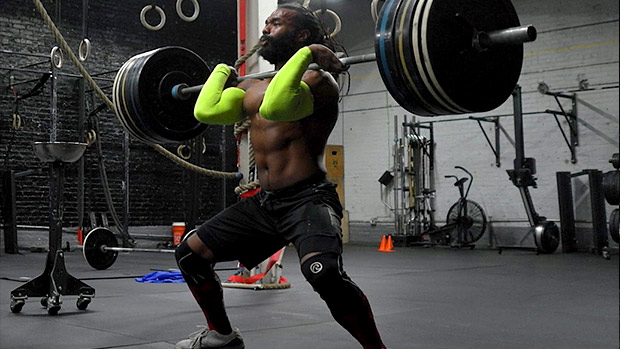Photo Credit: Zach Hodge, CrossFit Kingsboro
There are a lot of good things about CrossFit: A wide array of athlete skill acquisition, infinite scalability, development of all three energy systems, a motivating atmosphere, and a supportive community. But it does have its shortcomings.
Like any other fitness methodology, there are holes in its application. The biggest fault in most CrossFit programming is excessive (and in some cases, exclusive) sagittal plane movements.
As both a strength and conditioning coach and a CrossFit coach, I blend these two schools of thought in my coaching and programming styles. Good coaches aim to pull ideas from as many different resources as they can so they can give their athletes the best possible experience.
The big piece that's missing from the CrossFit prescription? Multiplanar movement.
What Planes?
Humans are made to move seamlessly through three different planes of movement: the sagittal, frontal, and transverse.
The sagittal plane consists of forward and backward movement – running, squatting, deadlifting, rowing, etc. all occur in this plane.
The frontal plane is made up of any lateral movement. Exercises like a lateral lunge or a shuffle primarily utilize this plane.
Finally (and perhaps most importantly), we have the transverse plane. Any rotational movements like a baseball pitch, chopping wood, or cutting direction in a sprint would be classified as being "transverse plane dominant exercises." Of course, we're never moving solely through one plane of movement at a time, but movements typically have a bias towards at least one of them.
Very few of the commonplace CrossFit exercises deviate from the sagittal plane. The only movements I can think of in differing planes would be the burpee-over-the-bar/bar-facing burpee and the Turkish get-up. Unfortunately, these aren't regularly-occurring movements in many boxes.
While every gym is different in its approach, I haven't found many boxes around the world that aim to utilize multiplanar movement in their regular programming.
Why is Multiplanar Programming Important?
Humans were made to run, jump, throw, carry, and much more. However, our bodies have a biological tendency to adapt to the way we move day after day.
Professional musicians who slump over their instruments for hours every day have a specific physiological adaptation to the activity, and many walk around with a slouched posture. Pitchers who throw hundreds of thousands of repetitions with one arm will develop one significantly stronger/tighter side and a subsequent rotation in their hips.
Our bodies operate on a "if you don't use it, you lose it" principle, but these things don't need to be permanent. We can readily reverse these adaptations.
If we don't prepare our bodies for movement in all three planes, then we're only strong in the sagittal plane. If someone is then introduced suddenly to a cutting drill or an exercise in an unfamiliar plane, he or she might be at an increased risk for injury. In field sports for example, ACL tears, ankle sprains, and other injuries often occur in quick changes of direction.
A 2006 study done on high school athletes concluded that sports with rapid directional changes are frequently associated with high ankle injury rates (Nelson et. al. 2006). If an athlete is ill-prepared for a movement, then the likelihood of injury is increased.
One of the most common dysfunctions I see is a weak gluteus medius. What's a primary function of that muscle? Abduction of the hip (which occurs in lateral movement). For these individuals, frontal plane movement becomes a focus of their training.
Individuals who don't rotate enough also develop stiffness in the core, the lats, and other surrounding muscles. As Dr. Perry Nickelston often says, "Power lives in the transverse plane." If we can teach CrossFitters how to develop transverse plane power, they're going to be able to sprint faster, gain multiplanar mobility and stability, and become more agile and more explosive. Sounds like a win.
How to Add Multiplanar Movement to Your Program
As mentioned, many of the staple CrossFit movements are sagittal plane-based, but that doesn't mean you can't utilize your own creative liberty when designing workouts.
A warm-up, for example, is an excellent opportunity for you to use different movement patterns. You can include change-of-direction drills like sprints, cutting cone drills, single-leg jumps, hurdles, and much more. These exercises will be a welcome change of pace.
Next, include accessory work at the beginning of a session with some different exercises. Landmine chops, medicine ball throws, and lateral step-ups/lunges are all movements that are extremely beneficial for developing overall strength and athleticism.
Goblet Lateral Lunge
Rotational Medball Throw
Landmine Chop
If you struggle to perform these exercises initially, that's okay! Likely that means that's exactly what you need to be doing.
A minimum of two workouts per week should introduce a non-sagittal exercise to break up the monotony. Implementing novel exercises into your programming arsenal will challenge and excite you, but it'll also help you to become more resilient.
If you want to become more athletic, then consider expanding your program to include transverse and frontal plane exercises on a regular basis.
Works Cited
- Nelson, A. J., Collins, C. L., Yard, E. E., Fields, S. K., & Comstock, R. D. (2007). Ankle Injuries Among United States High School Sports Athletes, 2005–2006. Journal of Athletic Training , 42 (3), 381–387.




